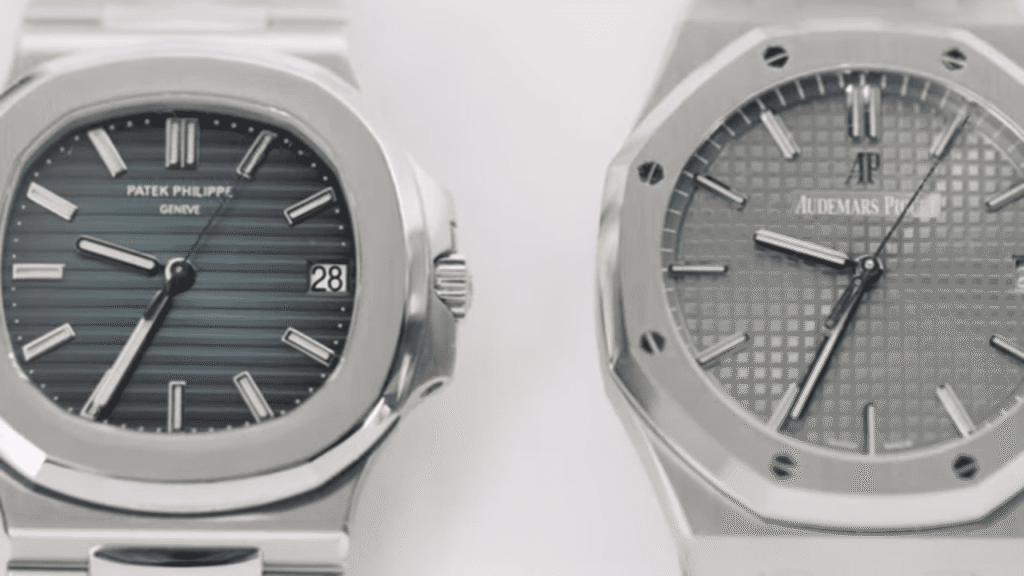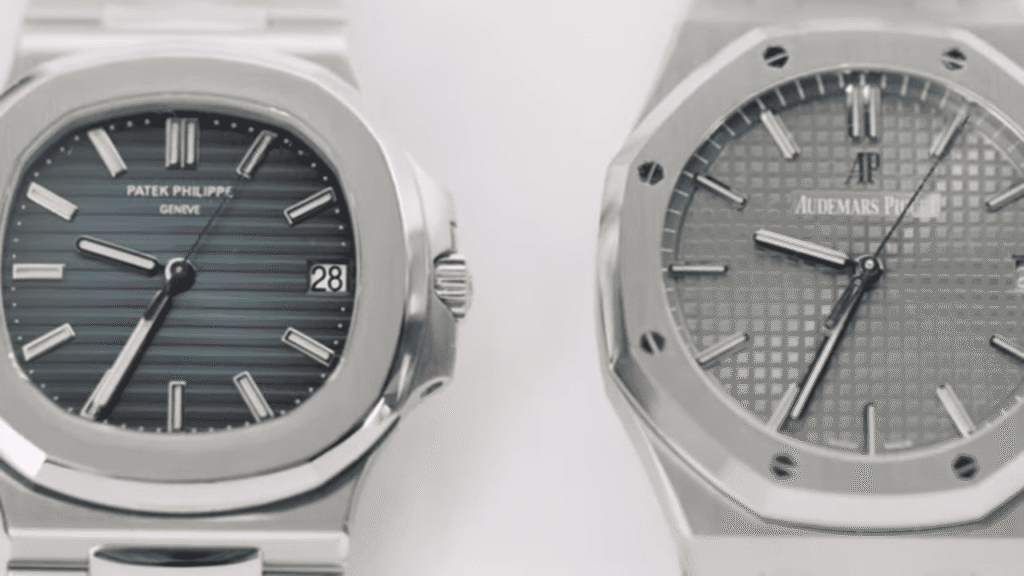
Royal Oak vs Nautilus — which steel sports watch wins
This isn’t just a watch comparison. This is the horological version of Ali vs Tyson. Two icons, both drawn by the same hand, but tuned for completely different souls, brought to you by Lugano Watches Dubai. The Audemars Piguet Royal Oak and the Patek Philippe Nautilus have spent decades circling each other in the rarefied air of ultra-luxury sport watches. People argue over them in private collectors’ dinners. Auction houses separate them with velvet ropes. Instagram comment sections lose their minds every time one appears.

AP Royal Oak vs. PP Nautilus: the story behind each icon tells you everything
And for good reason. They’re both legends. But they’re not the same.
So let’s go deep. Design, movement, collectability, presence, and purpose. And by the end of this, you might still not pick a side—but you’ll understand exactly what makes each of them tick.
Let’s start with context, because these two weren’t born from the same intention.
The Royal Oak was released in 1972. Audemars Piguet was fighting to survive the quartz crisis and knew it needed to do something unthinkable. So they called up Gérald Genta and asked him to design a watch that would change the conversation. Overnight, he drew a blueprint for the Royal Oak—a watch with an integrated bracelet, octagonal bezel, and a price tag higher than many gold watches at the time. It was made of steel, but priced like it was platinum.
The market’s reaction? Confused. But that confusion quickly turned to admiration. It became the blueprint for what a “luxury steel sports watch” could be. Thin, sharp, angular, brutalist, and elegant all at once.
Fast forward to 1976. Patek Philippe—watch royalty, known for conservative dress pieces and perpetual calendars—decided to respond. They hired Genta as well, who designed the Nautilus in less than five minutes at a hotel restaurant. Its porthole-inspired case, rounded octagon bezel, and horizontally embossed dial gave it a smoother, more maritime aesthetic than the Royal Oak. Less aggressive, more fluid.
So you have two watches from the same genius mind, but built for very different collectors. The Royal Oak for the rebel traditionalist. The Nautilus for the stealth wealth purist.

AP Royal Oak vs. PP Nautilus: details, finishing, and why each wears like nothing else
On paper, both the Royal Oak and Nautilus follow a similar recipe. Stainless steel. Integrated bracelet. Time-only (or complications hidden behind perfectly symmetrical designs). But side-by-side, the differences are clear.
The Royal Oak has sharper lines, more exposed hardware (those iconic bezel screws), and a more architectural vibe. It wears like a wrist sculpture. The level of finishing on a Royal Oak bracelet is absurd — alternating brushed and polished links, all hand-finished, with edges that catch light like a diamond blade. The tapisserie dial is cut with a pantograph, offering texture and depth that photos never do justice.
The Nautilus, on the other hand, is all about curves and restraint. Its rounded case and subtle transitions give it a softer wrist presence. The dial is clean, often with horizontal grooves, and the hands are sword-like and simple. The bracelet integrates flawlessly into the case, but where the Royal Oak feels mechanical, the Nautilus feels organic.
From a movement perspective, both houses bring their A-game. Earlier Royal Oaks used the ultra-thin JLC 2121 base. Today’s models (like the 16202) run AP’s in-house calibre 7121. The Nautilus, particularly the 5711, runs the Patek 26-330 S C—thin, beautifully decorated, with a gyromax balance and Spiromax hairspring.
Here’s where experts raise their eyebrows: Patek movements tend to edge out AP in finishing, with Geneva stripes, polished bevels, and gold rotors that could double as jewelry. But AP has made huge strides in the last decade, especially with the new calibres, making this a tight race.
On the wrist, the Nautilus wears flatter, lighter, more subtle. The Royal Oak has presence—it looks more watch. Which one wins? Depends on your personality. Are you front-row at Monaco GP or whispering at a private gallery in Zurich?

AP Royal Oak vs. PP Nautilus: collectability, market insanity, and which one actually holds power
Here’s where things get spicy. Both of these watches are technically “unobtainable” at retail unless you have a relationship, a history, or a direct bloodline to a watch executive. The secondary market? Wild.
The Royal Oak 15202ST (Jumbo Extra-Thin) regularly sold for 2-3x retail until AP discontinued it in 2022. Now? Prices are bouncing but still floating well into six figures. The new 16202 models are trickling in, but good luck getting one at retail.
The Nautilus 5711 was a monster. When Patek announced its discontinuation in 2021, the world went nuts. It became the watch to own. Prices hit nearly half a million USD at peak madness for a stainless steel three-hander. Even now, with the 5811 out and the market softening, the 5711 is still one of the most desirable watches on Earth.
But here’s the truth seasoned collectors know: the Royal Oak has more depth in the catalogue. Offshores. Perpetual calendars. Tourbillons. Concept models. There’s room to grow into the brand. Patek’s Nautilus line is tight and conservative. Fewer variations, more consistency.
From an investment perspective, both have their highs. But from a collecting standpoint, the Royal Oak offers more exploration, while the Nautilus retains that impossible-to-duplicate Patek mystique.

AP Royal Oak vs. PP Nautilus: So who wins?
Wrong question.
The Royal Oak wins if you want edge, sharpness, and horological rebellion made wearable. It has grit, history, and an almost brutalist sense of elegance.
The Nautilus wins if you want fluidity, restraint, and one of the best-finished steel watches ever produced. It is the quiet king of the high-table.
But here’s what makes this rivalry so brilliant: you can’t fake either of them. You can’t buy your way into either brand without time, patience, or an unreasonable amount of luck. And once you own one, you don’t just have a watch. You have a story. A position. A point of view.
Because in the world of steel sports watches, the Royal Oak and the Nautilus are not just competitors. They’re reflections of what kind of collector you are.
And if you’re asking this question in the first place, chances are… you’re ready for both.
